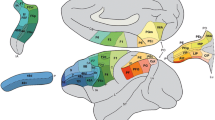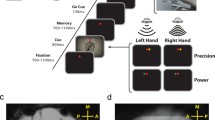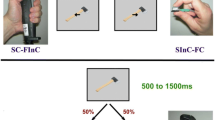Abstract
Positron emission tomography (PET) was used to localize brain regions that are active during the observation of grasping movements. Normal, right-handed subjects were tested under three conditions. In the first, they observed grasping movements of common objects performed by the experimenter. In the second, they reached and grasped the same objects. These two conditions were compared with a third condition consisting of object observation. On the basis of monkey data, it was hypothesized that during grasping observation, activations should be present in the region of the superior temporal sulcus (STS) and in inferior area 6. The findings in humans demonstrated that grasp observation significantly activates the cortex of the middle temporal gyrus including that of the adjacent superior temporal sulcus (Brodmann's area 21) and the caudal part of the left inferior frontal gyrus (Brodmann's area 45). The possible functional homologies between these areas and the monkey STS region and frontal area F5 are discussed.
Similar content being viewed by others
References
Bailey P, Bonin G von (1951) The isocortex of man. University of Illinois Press, Urbana
Bettinardi V, Scardaoni R, Gilardi MC, Rizzo G, Perani D, Paulesu E, Striano G, Triulzi F, Fazio F (1991) Head holder for PET, CT, MR studies. J Comp Assist Tomogr 15: 886–892
Bonda E, Petrides M, Frey S, Evans AC (1994) Frontal cortex involvement in organized sequences of hand movements: evidence from a positron emission tomography study. Soc Neurosci Abstr 20: 152.6
Bonin G von, Bailey P (1947) The neocortex of Macaca mulatta. University of Illinois Press, Urbana
Brodmann K (1909) Vergleichende Lokalisationslehre der Grosshirnrinde. Barth, Leipzig (reprinted 1925)
Brothers L, Ring B, Kling A (1990) Response of neurons in the macaque amygdala to complex social stimuli. Behav Brain Res 41: 199–213
Bruce CJ (1988) Single neuron activity in the monkey's prefrontal cortex. In: Rakic P, Singer W (eds) Neurobiology of neocortex. Wiley, Chichester, pp 297–329
Bruce CJ, Desimone R, Gross CG (1981) Visual properties of neurons in a polysensory area in superior temporal sulcus of the macaque. J Neurophysiol 46: 369–384
Bruce CJ, Goldberg ME, Bushnell MC, Stanton GB (1985) Primate frontal eye fields. II. Physiological and anatomical correlates of electrically evoked eye movements. J Neurophysiol 54: 714–734
Campbell AW (1905) Histological studies on the localization of cerebral function. Cambridge University Press, New York
Chollet F, Di Piero V, Wise RSJ, Brooks DJ, Dolan RJ, Frackoviak RSJ (1991) The functional anatomy of functional recovery after stroke in humans. Ann Neurol 29: 63–71
Colebatch JG, Deiber M-P, Passingham RE, Friston KJ, Frackowiak RSJ (1991) Regional cerebral blood flow during voluntary arm and hand movements in human subjects. J Neurophysiol 65: 1392–1401
Decety J, Perani D, Jeannerod M, Bettinardi V, Tadary B, Woods R, Mazziotta JC, Fazio F (1994) Mapping motor representations with positron emission tomography. Nature 371: 600–602
Deiber M-P, Passingham RE, Colebatch JG, Friston KJ, Nixon PD, Frackowiak RSJ (1991) Cortical areas and the selection of movement: a study with positron emission tomography. Exp Brain Res 84: 393–402
Desimone R, Albright TD, Gross CG, Bruce C (1984) Stimulusselective properties of inferior temporal neurons in the macaque. J Neurosci 8: 2051–2062
di Pellegrino G, Fadiga L, Fogassi L, Gallese V, Rizzolatti G (1992) Understanding motor events: a neurophysiological study. Exp Brain Res 91: 176–180
Distler C, Boussaoud D, Desimone R, Ungerleider LG (1993) Cortical connections of inferior temporal area TEO in macaque monkeys. J Comp Neurol 334: 125–150
Economo C von (1929) The cytoarchitectonics of the human cerebral cortex. Oxford University Press, London
Fadiga L, Fogassi L, Pavesi G, Rizzolatti G (1995) Motor facilitation during action observation: a magnetic stimulation study. J Neurophysiol 73: 2608–2611
Felleman DJ, Van Essen DC (1991) Distributed hierarchical processing in primate cerebral cortex. Cerebral Cortex 1: 1–47
Friston KJ, Frith CD, Liddle PF, Dolan RJ, Lammertsma AA, Frackoviak RSJ (1990) The relationship between global and local changes in PET scans. J Cerebr Blood Flow Metab 10: 458–466
Friston KJ, Frith CD, Liddle PF, Frackoviak RSJ (1991) Comparing functional (PET) images: the assessement of significant change. J Cerebr Blood Flow Metab 11: 690–699
Gallese V, Buccino G, Fadiga L, Fogassi L, Rizzolatti G, Tedeschi P (1995) Reversible inactivation of inferior premotor areas (F4 and F5) and primary motor cortex (F1) in the macaque mokey. Eur J Neurosci, suppl. 8:50
Gallese V, Fadiga L, Fogassi L, Rizzolatti G (1996) Action recognition in the premotor cortex. Brain 119:593–609
Gentilucci M, Fogassi L, Luppino G, Matelli M, Camarda R, Rizzolatti G (1988) Functional organization of inferior area 6 in the macaque monkey: I. Somatotopy and the control of proximal movements. Exp Brain Res 71: 475–490
Grafton ST, Woods RP, Mazziotta JC (1993) Within-arm somatotopy in human motor areas determined by positron emission tomography imaging of cerebral blood flow. Exp Brain Res 95: 172–176
Grafton ST, Fagg AH, Woods RP, Arbib MA (1996) Functional anatomy of pointing and grasping in humans. Cerebral Cortex, in press
Gross CG, Rocha-Miranda CE, Bender DB (1972) Visual properties of neurons in the inferotemporal cortex of the macaque. J Neurophysiol 35: 96–111
Gross CG, Desimone R, Albright TD, Schwartz EL (1985) Inferior temporal cortex and pattern recognition. In: Chagas C, Gattass R, Gross C (eds) Pattern recognition mechanisms. Springer, Berlin Heidelberg New York, pp 179–201
Hast MH, Fisher JM, Wetzel AB, Thompson VE (1974) Cortical motor representation of the laryngeal muscles in Macaca mulatta. Brain Res 73: 229–240
Hayes TL, Lewis DA (1995) Anatomical specialization of the anterior motor speech area: hemispheric differences in magnopyramidal neurons. Brain Lang 49: 289–308
Hepp-Reymond M-C, Husler EJ, Maier MA, Qi H-X (1994) Force-related neuronal activity in two regions of the primate ventral premotor cortex. Can J Physiol Pharmacol 72: 571–579
Jeannerod M (1994) The representing brain: neural correlates of motor intention and imagery. Behav Brain Sci 17: 187–245
Jeannerod M, Arbib MA, Rizzolatti G, Sakata H (1995) Grasping objects: the cortical mechanisms of visuomotor transformation. Trends Neurosci 18: 314–320
Kobatake E, Tanaka K (1994) Neuronal selectivities to complex object features in the ventral visual pathway of the macaque cerebral cortex. J Neurophysiol 71: 856–867
Leonard CM, Rolls ET, Wilson FAW, Baylis GC (1985) Neurons in the amygdala of the monkey with responses selective for faces. Behav Brain Res. 15: 159–176
Liberman AM, Mattingly IG (1985) The motor theory of speech perception revised. Cognition 21: 1–36
Matelli M, Luppino G, Rizzolatti G (1985) Patterns of cytochrome oxidase activity in the frontal agranular cortex of macaque monkey. Behav Brain Res 18: 125–137
Matelli M, Camarda R, Glickstein M, Rizzolatti G (1986) Afferent and efferent projections of the inferior area 6 in the macaque monkey. J Comp Neurol 251: 281–298
Matelli M, Rizzolatti G, Bettinardi V, Gilardi MC, Perani D, Rizzo G, Fazio F (1993) Activation of precentral and mesial motor areas during the execution of elementary proximal and distal arm movements: a PET study. Neuroreport 4: 1295–1298
Matelli M, Luppino G, Murata A, Sakata H. (1994) Independent anatomical circuits for reaching and grasping linking the inferior parietal sulcus and inferior area 6 in macaque monkey. Soc Neurosci Abstr 20: 404.4
Matsumura M, Kubota K (1979) Cortical projection of hand-arm motor area from postarcuate area in macaque monkey: a histological study of retrograde transport of horseradish peroxidase. Neurosci Lett 11: 241–246
Mesulam MM (1990) Large-scale neurocognitive networks and distributed processing for attention, language, and memory. Ann Neurol 28: 597–613
Muakkassa KF, Strick PL (1979) Frontal lobe inputs to primate motor cortex: evidence for four somatotopically organized “premotor” areas. Brain Res 177: 176–182
Oldfield RC (1971) The assessment and analysis of handedness: the Edinburgh Inventory. Neuropsychologia 9: 97–113
Oram MW, Perrett DI (1994) Responses of anterior superior temporal polysensory (STPa) neurons to “biological motion” stimuli. J Cogn Neurosci 6: 99–116
Parsons LM, Fox PT, Downs JH, Glass T, Hirsch TB, Martin CC, Jerabek PA, Lancaster JL (1995) Use of implicit motor imagery for visual shape discrimination as revealed by PET. Nature 375: 54–58
Passingham R (1993) The frontal lobes and voluntary action. Oxford University Press, Oxford
Perrett DI, Rolls ET, Caan W (1982) Visual neurones responsive to faces in the monkey temporal cortex. Exp Brain Res 47: 329–342
Perrett DI, Harries MH, Bevan R, Thomas S, Benson PI, Mistlin AJ, Chitty AI, Hietanen JK, Ortega JE (1989) Frameworks of analysis for the neural representation of animate objects and actions. J Exp Biol 146: 87–113
Perrett DI, Mistlin AJ, Harries MH, Chitty AJ (1990) Understanding the visual appearance and consequence of hand actions. In: Goodale MA (ed) Vision and action: the control of grasping. Ablex, Norwood, NJ, pp 163–180
Petrides M, Pandya DN (1994) Comparative architectonic analysis of the human and the macaque frontal cortex. In: Boller F, Grafman J (ed) Handbook of neuropsychology vol IX. Elsevier, Amsterdam, pp 17–58
Rizzolatti G, Camarda R, Fogassi M, Gentilucci M, Luppino G, Matelli M (1988) Functional organization of inferior area 6 in the macaque monkey: II. Area F5 and the control of distal movements. Exp Brain Res. 71: 491–507
Rizzolatti G, Fadiga L, Gallese V, Fogassi L (1996) Premotor cortex and the recognition of motor actions. Cogn Brain Res 3: 131–141
Sakata H, Taira M, Mine S, Murata A (1992) Hand-movement related neurons of the posterior parietal cortex of the monkey: their role in visual guidance of hand movements. In: Caminiti R, Johnson PB, Burnod Y (eds) Control of arm movement in space. (Exp Brain Res Suppl 22) Springer, Berlin Heidelberg New York, pp 185–198
Schlaug G, Knorr U, Seitz RJ (1994) Inter-subject variability of cerebral activations in acquiring a motor skill: a study with positron emission tomography. Exp Brain Res 98: 523–534
Seltzer B, Pandya DN (1989) Frontal lobe connections of the superior temporal sulcus in the rhesus monkey. J Comp Neurol 281: 97–113
Spinks TJ, Jones T, Gilardi MC, Heather JD (1988) Physical performance of the latest generation of commercial positron scanners. IEEE Trans Nucl Sci 35: 721–725
Suzuki H, Azuma M (1983) Topographic studies on visual neurons in the dorsolateral prefrontal cortex of the monkey. Exp Brain Res 53: 47–58
Taira M, Mine S, Georgopulos AP, Murata A, Sakata H (1990) Parietal cortex neurons of the monkey related to the visual guidance of hand movement. Exp Brain Res 83: 29–36
Talairach J, Tournoux P (1988) Co-planar stereotaxic atlas of the brain. Thieme, New York
Tanaka K, Saito HA, Fukada Y, Moriya M (1991) Coding visual images of objects in the inferotemporal cortex of the macaque monkey. J Neurophysiol 66: 170–189
Tanji J, Kurata K (1982) Comparison of movement-related activity in two cortical motor areas of primates. J Neurophysiol 57: 633–653
Tootell RBH, Reppas JB, Dale AM, Look RB, Sereno MI, Malach R, Brady TJ, Rosen BR (1995) Visual motion aftereffect in human cortical area MT revealed by functional magnetic resonance imaging. Nature 375: 139–141
Ungerleider LG, Mishkin M (1982) Two cortical visual systems. In: Ingle DJ, Goodale MA, Mansfield RJW (eds) Analysis of visual behavior. MIT Press, Cambridge, Mass., pp 549–586
Walker AE (1940) A cytoarchitectonical study of the prefrontal area of the macaque monkey. J Comp Neurol 262: 256–270
Watson JD, Myers R, Frackoviak RSJ, Hajnal JV, Woods RP, Mazziotta JC, Shipp S, Zeki S (1993) Area V5 of the human brain: evidence from a combined study using positron emission tomography and magnetic resonance imaging. Cerebral Cortex 3: 79–94
Weiller C, Chollet F, Friston KJ, Wise RJS, Frackowiak RSJ (1992) Functional reorganisation of the brain in recovery from striatocapsular infarction in man. Ann Neurol 31: 463–472
Weiller C, Ramsay SC, Wise RJS, Friston KJ, Frackowiak RSJ (1993) Individual patterns of functional reorganisation in the human cerebtral cortex after capsular infarction. Ann Neurol 33: 181–189
Zeki SM, Watson JDG, Lueck CJ, Friston KJ, Kennard C, Frackowiack RSJ (1991) A direct dimonstration of functional specialization in human visual cortex. J Neurosci 11: 641–649
Author information
Authors and Affiliations
Rights and permissions
About this article
Cite this article
Rizzolatti, G., Fadiga, L., Matelli, M. et al. Localization of grasp representations in humans by PET: 1. Observation versus execution. Exp Brain Res 111, 246–252 (1996). https://doi.org/10.1007/BF00227301
Received:
Accepted:
Issue Date:
DOI: https://doi.org/10.1007/BF00227301




